







IPCS |
International Programme on Chemical Safety |
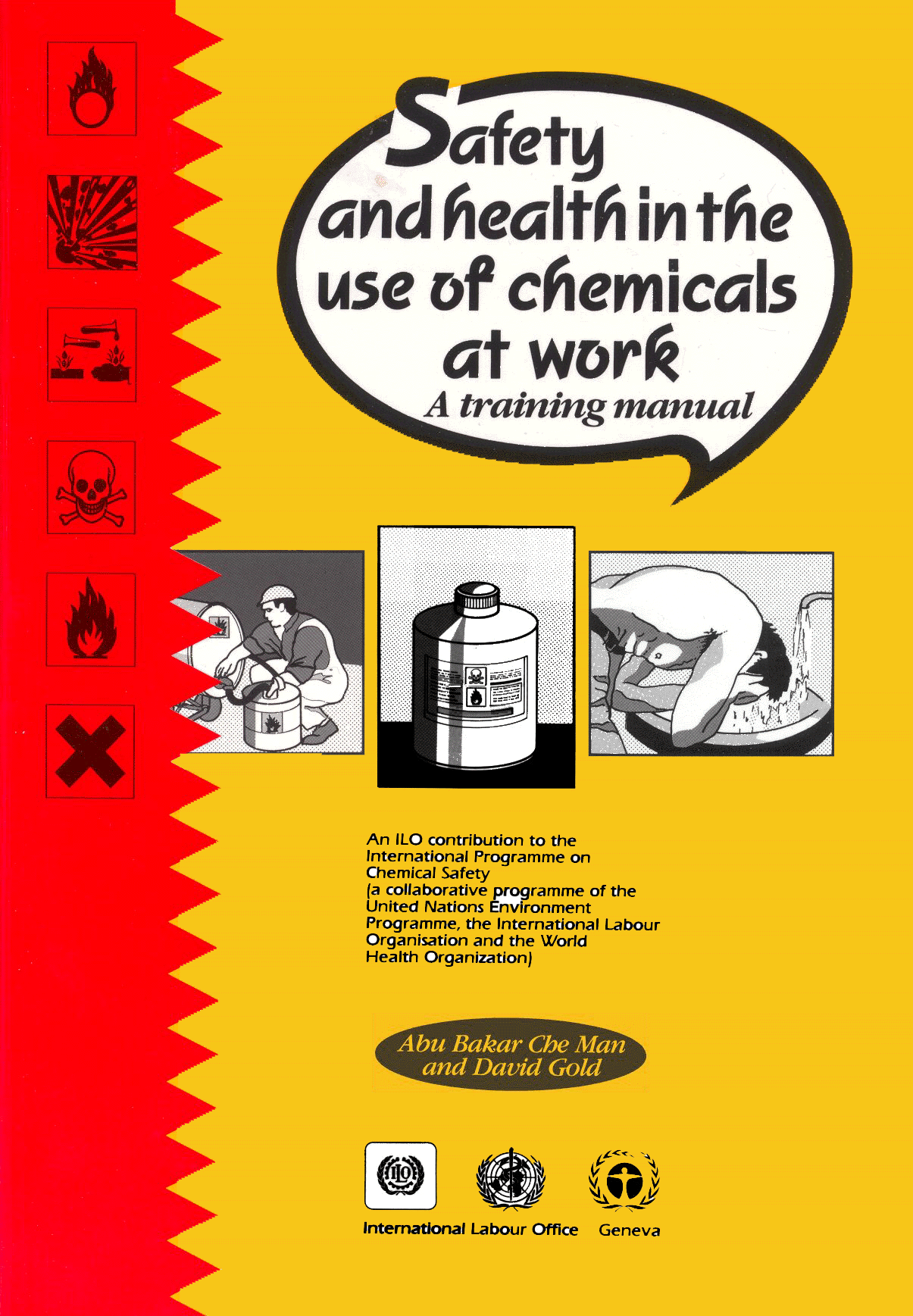 Safety and Health in the Use of Chemicals at Work
Safety and Health in the Use of Chemicals at Work
A training manual
Abu Bakar Che Man and David Gold
An ILO contribution to
the International Programme on Chemical Safety
(a collaborative programme of the United Nations Environment Programme, the International
Labour Organization and the World Health Organization)
4. Basic principles of prevention
4. 1. Four principles of operational control
The general objective in the control of hazards relating to chemicals in the workplace is to eliminate or reduce to the lowest possible level the hazardous chemicals that can come into contact with the worker or the environment, or that can produce a fire or an explosion.
To achieve this, a four-point strategy of operational control is used to prevent or reduce the possibility of exposure to chemicals, and thus decrease the risk of accidents, and fires and explosions due to chemicals.
Ideally, the best method of preventing diseases and injuries, and fires and explosions caused by chemicals would be to provide a working environment free from such chemicals. However, this is not always feasible. Therefore, it is necessary to isolate the danger, increase ventilation or use personal protective equipment But first it is essential to identify the chemical hazard and the extent of its risk, and to examine the inventory, storage, process of transfer and handling, and the actual use of the chemical and its disposal. In dealing with each specific hazard, the following four points should be considered as a prevention strategy
Four
principles of operational control
|
4. 1. 1. Elimination or substitution
The most efficient way to reduce chemical hazards is to avoid using toxic substances or substances that pose a risk of fire or explosion. The selection of the chemical substance should be made at the design and planning stage of the process. For existing processes, the substitution method should be used wherever hazardous substances or processes may be replaced with others that are less hazardous.
Examples of substituting for toxic substances are:
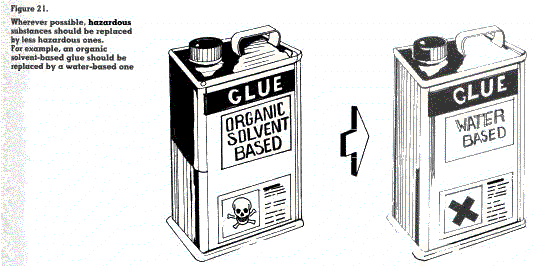
Examples of process substitution are:
| Remember: Try to reduce the risk by eliminating the chemical hazard or replacing the chemical with a less hazardous one. |
The choice of alternative substances may be limited, especially where the use of that particular substance is unavoidable if the technical and economic requirements are to be met. It is always useful to look for alternative substances by learning from experiences in similar circumstances.
Discussion questions:
4.1.2. Putting distance or shielding between the substance and the worker
This method involves enclosing processing equipment in order to restrict the spread of air contaminants to the workplace environment and isolating sources of heat from open flames or fuels. It is ideal for processes in which the worker has minimal chances of coming into contact with the chemical in question. Examples of this method are screening the whole machine, enclosing dust-producing transfer points of conveyors, or shielding abrasive blasting operation processes.
Contact with hazardous chemicals can also be reduced by isolation, which entails moving the hazardous processes or operations to a remote location in the plant or constructing a barrier to separate them from other processes (figure 22).
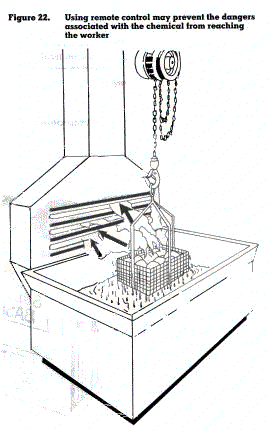
Examples of isolation are abrasive blasting of huge structures in a remote area of the workplace, or separating a spray painting process from the . other processes of the plant by means of a barrier or wall. A similar isolating effect can be obtained by the safe storage of hazardous chemicals and by restricting the amounts of these chemicals in the workplace to that required in a day or a shift. Such restriction is useful if the process can be carried out by a very small number of workers and when control by other methods is difficult or impossible. The workers engaged in this process, however, should be given adequate personal protection.
In the case of airborne chemicals, ventilation is regarded as one of the best forms of control apart from substitution and enclosure. By means of adequate ventilation, we can trap contaminants released into the air from the process or operation and prevent them from entering the breathing zone of the worker. The trapped contaminants are conveyed by ducts to a collector (cyclone, filter house, scrubbers or electrostatic precipitators) where they are removed before the air is ,discharged into the outside environment. This is accomplished by a special exhaust system or by increasing the general ventilation.
Figure 23 shows two methods of local ventilation. In the case of an exhaust ventilation system, hoods at the point where the air enters the system must be located as close as possible to the source of the contaminant, otherwise the draught induced by the system's fan will not be strong enough to capture the contaminant. In order to ensure the efficiency of an exhaust ventilation system, it is important to check its design by getting advice from a specialist or person trained in installing ventilation systems. The system should be regularly maintained to keep it operating efficiently. Exhaust ventilation systems have been used effectively to control toxic substances such as lead, asbestos and organic solvents.
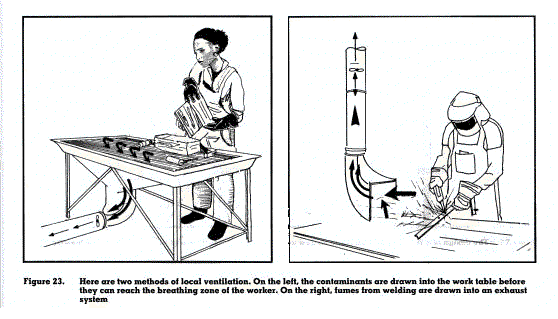
General ventilation is also known as dilution ventilation. It works by diluting the air contaminants or the concentration of flammable vapours through pushing air to and from the workplace. This system uses natural air movement from open windows or doors, or from a mechanical air-moving device. The airflow should be taken into account in the design of a building (figure 24). Because it tends to disperse the contaminants instead of removing them, this system is recommended only for substances with low toxicity, non-corrosive and used in small quantities.
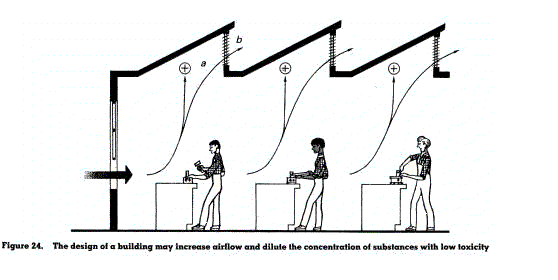
Discussion question:
What kinds of local ventilation are used in your workplace? Are they effective?
4.1.4. Personal protective equipment
If it is not possible to reduce chemical hazards to an acceptable level, workers must be protected by using personal protective equipment. This equipment forms a barrier between the toxic chemical and the route of entry and does nothing to reduce or eliminate the hazard. Failure of the equipment therefore means immediate exposure to the hazard. Thus, personal protective equipment should not be regarded as a primary means to control hazards but rather as a supplement to other types of control measure. With the risks of fire and explosion there are no sure ways to provide equipment to protect the workers.
Respirators, which cover the mouth and nose of the worker, prevent the entry of chemicals into the body by inhalation. The use of respirators should be confined to situations:
Respirators should be selected according to the following criteria:
They can be divided into two types: airpurifying and air-supply respirators.
Air-purifying respirators clean the air by filtering or absorbing contaminants before they enter the respiratory system. The cleaning devices are made of filters for removing dust from the air (figure 25), or chemical cartridges or canisters for absorbing gases, fumes, vapours, and mists (figure 26). These respirators come in the form of half-face (covering the mouth, nose and chin) or full-face masks (covering the face including the eyes). There are no filter-type or cartridge-type respirators which can protect the worker from all hazardous chemicals.
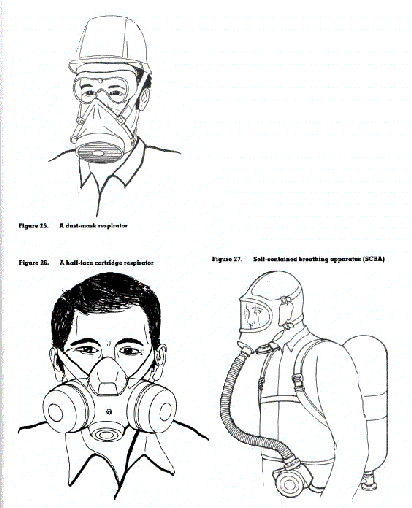
The types of filter and of cartridge of canister differ according to types of dust or of gaseous contaminants. It is essential to obtain advice on the proper type of respirator for a given hazard from the supplier of the respirator.
Air-supply respirators provide a continuous supply of uncontaminated air and offer the highest level of respiratory protection. Air can be pumped either from a remote source (connected by a highpressure hose) or from a portable supply (such as from a cylinder or a tank c6 containing compressed or liquid air or oxygen). This portable type, illustrated in figure 27, is known as self-contained breathing apparatus (SCBA). The mask of airsupply breathing apparatus is designed to cover the whole face.
To ensure effective use, workers must be trained and educated in the proper use, care and maintenance of respirators (figure 28). Wearing a properly maintained respirator can be more dangerous than not wearing one at all. In this situation the workers think that they are protected while in reality they are not.
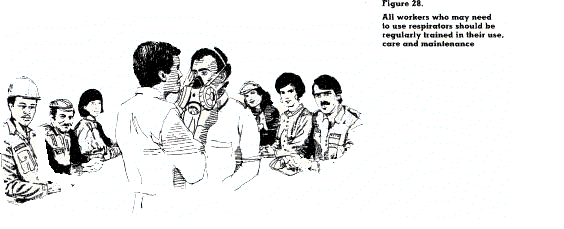
4.1.4.2. Other personal protective equipment
Protecting the eyes and skin from chemical splashes and exposure to dusts, vapours, mists and fumes may require appropriate protective equipment.
Examples of eye and face protection include safety glasses, safety goggles (figure 29) and face shields used to protect against corrosive liquids, solids and vapours, and other foreign bodies (figure 30).
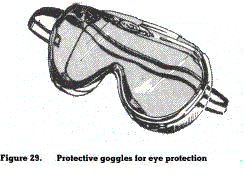
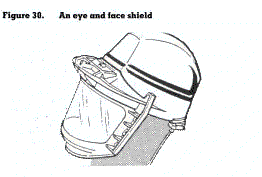
To protect the skin, protective clothing such as gloves, aprons, boots and coveralls, made from impervious materials, should be provided to eliminate prolonged or repeated contact with solvents or other provided to eliminate prolonged or repeated contact with solvents or other chemicals. A wide range of materials is used to make these protective devices, and proper selection is essential. For example, cotton and leather gloves are suitable for protecting hands from dust, while rubber gloves are suitable for protection against corrosive substances (figure 3 1). The main consideration is that these materials offer resistance to chemicals. Suppliers of protective equipment should be able to give advice in this respect.
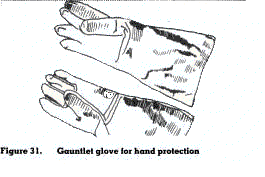
Protective creams and lotions are also available for protecting the skin. Their effectiveness varies, but if properly selected and applied they can be very useful. There is no all-purpose cream; some are made to protect against organic solvents while others are designed for water-soluble substances.
Discussion questions:
| Remember:
Personal protective equipment should be appropriate to the hazard and great care should be taken to fit the equipment to the worker. |
Personal hygiene aims to keep the body clean and not allow anything harmful to remain on it for long periods as it can be absorbed through the skin. It is equally important to avoid inhaling or ingesting small, even minute, quantities of chemicals because of their harmful effects on health.
The basic rules of personal hygiene in using chemicals at work are as follows:
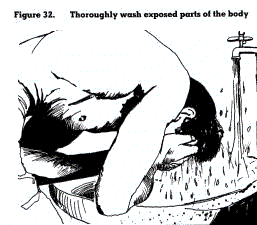
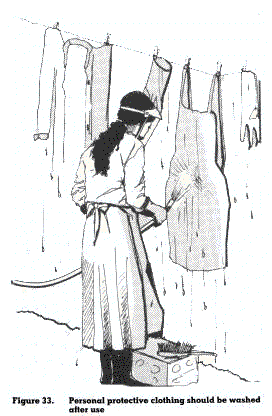
There are other hygienic measures to be observed:
Organizational control refers to measures and procedures established by management as part of a programme to control exposure, or to monitor the effectiveness of other control measures. The following measures should be taken:
Further details of these aspects as part of a chemical control programme are given in Chapter 6.
The principles of hazard identification are to know what chemicals are used or produced, how these chemicals come into contact with the body and cause injury or disease, how they may cause a fire or explosion in the workplace or how a spill or leak may cause harm to the environment.
Every chemical substance in the workplace should be known and accompanied by an appropriate label and an up-to-date chemical safety data sheet. To obtain this information, the employer should first request it from the supplier of the chemical. If the supplier does not have the information, the employer should then seek advice from the government, laboratories, universities or other specialized institutions.
In fact, any chemical that cannot be identified, labeled or provided with a chemical safety data sheet should not be used until the relevant safety and health information has been obtained from the supplier and provided to workers and their representatives in a form and language which they can easily understand.
Drums, bags and any other containers holding chemicals should be frequently checked for proper labels. The purpose of labeling is to warn workers of the potential hazards of the chemicals, the necessary precautionary measures and what to do in case of an emergency (figure 34).
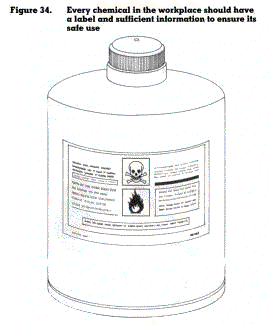
The following information should, as appropriate, be included on the label:
When a hazardous chemical has been transferred from its original shipping container, the secondary and all subsequent containers should carry the appropriate warning labels. Labels should be affixed to all containers from the origins of the chemical to its neutralization or disposal. Any chemical that cannot be readily identified should be properly disposed of.
4.2.3. Chemical safety data sheets
Chemical safety data sheets should be available for every chemical substance within the enterprise. The data sheet provides basic information about the chemical and safety in its use (figure 35). It also indicates appropriate precautions, including personal protective equipment, as well as emergency procedures.
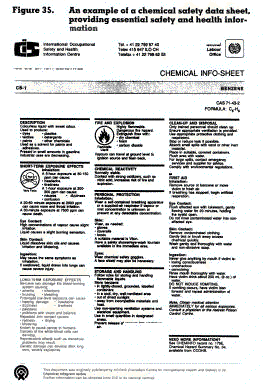
Discussion questions:
| Remember: Every chemical container in the workplace, no matter how small, should have an appropriate, understandable label. |
The following information is normally included or medical facility to assist in rapid identification on the chemical safety data sheet:
If chemical safety data sheets are not available, they should be immediately obtained from the supplier.
From the knowledge of the industrial process and the information on the chemical safety data sheet, a careful analysis needs to be carried out by management to determine chemical compatibility, and procedures for storage, transfer, handling, use and disposal. Such elements on the chemical safety data sheet as chemical and physical properties, stability and reactivity, and toxicological information are essential information for carrying out the analysis and planning appropriate control strategies. A complete set of chemical safety data sheets should be kept on file with the safety officer, occupational health service and in-plant fire brigade, if this exists, and should be immediately available to first-aid teams. When an emergency occurs and a worker is exposed to a chemical, the chemical safety data sheet should be brought to the doctor and treatment.
The information provided on chemical safety data sheets should also serve as a basis for the preparation of oral and written instructions to workers, and for the training of workers and supervisors in the safe use of specific chemicals. This training should include instructions for workers on how to obtain and use the information provided on the chemical safety data sheet.
Discussion questions:
If a hazardous chemical cannot be replaced by a less hazardous one, the quantity of the chemical at or near the workstation should be reduced to that required for daily use (one shift). The remainder should be kept in a safe chemical storage area.
The following general rules should be followed to ensure safety in the storage of chemicals:
For chemicals that pose a risk of fire or explosion, the following additional rules should be observed:
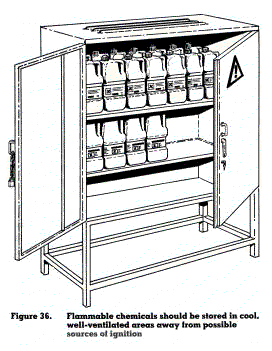
the storage facility should be separated from the plant and living quarters, and away from sources of drinking-water;
Discussion questions:
4.2.5. Procedures for safe transfer
Chemicals may be transferred to or from work areas through pipelines or conveyors, or by using forklift trucks, trolleys or wheelbarrows.
If chemicals are transported through pipelines, care must be taken to ensure that valves and flanges are intact and do not leak. If conveyors are used, the spread of hazardous dusts can be avoided if the conveyors and their transfer points are covered. If chemicals are transported at high speed and pressure through manifold systems, care must also be taken to avoid a build-up of heat, thus creating the risk of fire or explosion.
Containers for flammable liquids should be specially constructed with spring-loaded caps and flame arresters in their spouts. The transfer of flammable liquids should only be carried out in well-ventilated areas with the containers earthed and bonded (figure 37).
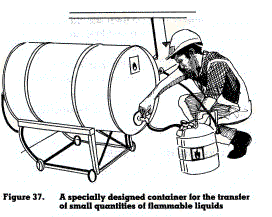
If chemicals are transported by forklift truck, clearly marked passageways of an adequate width can reduce the possibility of collision and spillage.
Discussion questions:
As discussed in Chapter 2, there are three principal ways in which chemicals can enter the body, through absorption, inhalation and ingestion. In the workplace the most common route of entry is inhalation, followed by skin absorption.
To be inhaled, chemicals must be airborne in the form of dusts, vapours, mists or fumes. Dust is frequently formed during grinding, crushing, cutting, drilling or breaking operations. Vapours are generated by heated liquids or solids. Mists are produced from spraying, electroplating or boiling operations. Fumes arise from molten metals during welding or casting operations.
Skin absorption usually occurs when liquid chemicals are handled. Splashing of liquids on to exposed skin or clothing is the most common mode of contact. This may happen during operations such as dipping parts into degreasing tanks, using cutting oil during machine operations or transferring liquids.
Often these same processes pose a risk of fire or explosion due to the nature of the chemical involved. It is essential to control the sources of heat in order to reduce the risk if a substitute chemical is not available.
Certain precautions should be taken before handling or using chemicals:
During the handling and use of hazardous chemicals, prevention of exposure can best be achieved by following the principles of control, which are repeated here:
Discussion questions:
Good housekeeping plays an important role in the control of chemical hazards. Dust on workbenches, floors or ledges should be cleaned regularly by vacuuming rather than by compressed air or sweeping. Spilled liquids should be deposited in airtight receptacles and removed daily from the work area. Chemicals stored in damaged or leaking containers should be transferred to sound ones, and the damaged container disposed of accordingly.
All manufacturing processes generate a certain amount of waste. Improper disposal of hazardous waste not only poses a health hazard to workers, and a potential fire and explosion risk, but also endangers the environment and people living in close proximity to the plant.
All waste products should be stored in properly labeled, specially designed waste containers. Any empty containers or bags previously containing toxic or flammable substances should be disposed of in such containers.
There should be an established written procedure for the disposal of toxic and hazardous waste. The safety of the workers handling the hazardous waste should also be ensured through appropriate control measures.
A monitoring programme in the workplace includes the taking of air samples to determine the concentration of chemicals in the atmosphere. These chemicals may be in the form of dusts, vapours, gases or fumes.
The air is sampled either by attaching a personal monitoring device within the breathing zone of the worker (figure 38) or by placing an airsampling device in specific areas of the workplace.
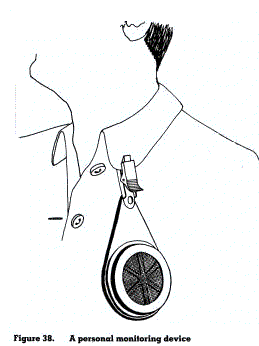
The sampling can be done over either a short or long period of time. The analysis of the results will indicate the concentration of a specific chemical or other air contaminants that existed at the time of sampling. This concentration will in turn be compared either with an exposure limit value issued by the competent national authority or with any other widely accepted set of exposure limit values. Once a problem is identified, control measures should be implemented to reduce the exposure of the worker.
Medical surveillance includes pre-placement and periodic medical examinations (figure 39). Pre-placement examinations provide an opportunity to detect hypersusceptible workers and accordingly assign them to jobs or workplaces where their health will not be at risk. Periodic examinations help detect early symptoms of occupational diseases, and also verify whether control measures are operating efficiently.
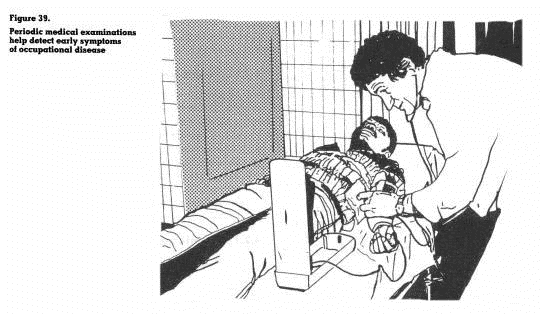
All environmental and medical surveillance records should be kept and maintained in good order. Some of the diseases caused by chemicals have long latency periods. These records will therefore be useful in the future to help medical practitioners make diagnoses for compensation purposes, and to provide valuable information for epidemiological studies which will contribute to the further understanding of the health hazards of chemicals.
4.2.12. Training and education
Training and education play an important role in the control of chemical hazards (figure 40). People who work with chemicals should be instructed in the possible hazards caused by the chemicals, safe working procedures, the care and use of protective equipment, and emergency and first-aid measures (see section 5.4 on first aid).
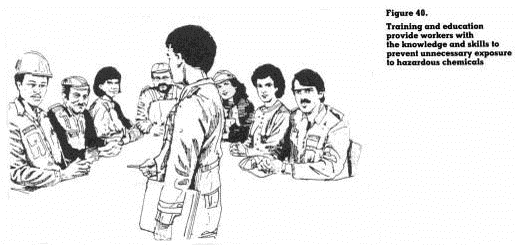
Workers should be trained to identify when control measures fail and to interpret the labels and hazard information provided for the chemicals. Training is essential for new workers, while existing workers should undergo periodic refresher courses.
Further information on training is given in sections 6.2.5.2 and 6.2.5.7.
Suggested further reading:
5. Chemical emergency procedures
Throughout this manual we have stressed the prevention of disease, injury, fires and explosions. Realistically, however, it is not possible to prevent every accident from occurring.
Everyone who comes into contact with hazardous chemicals must not only be aware of preventive measures but must also know about emergency procedures, which may in fact prevent a minor incident from becoming a major catastrophe. These procedures include first-aid measures, fire-extinguishing techniques, and spill and leak procedures. Appropriate action in the first few seconds could prevent a disaster.
As with preventive measures, the key to emergency procedures lies with a sound knowledge of the chemical substances used in the plant and rapid access to sources of information. Chemical safety data sheets provide a great deal of information on first-aid measures, fire-fighting techniques, and spill and leak procedures. The label affixed to the chemical may also be an invaluable source of information during an emergency.
| Remember: Knowledge about the chemical, sources of information and emergency measures are best obtained before an emergency occurs. |
It may also happen that chemicals that are stored together may accidentally mix during an emergency, forming a new substance with totally different characteristics. The plant chemist or industrial hygienist should be able to provide you with advice about the appropriate storage of chemicals, in order to keep non-compatible chemical substances away from each other.
If the possibility still exists that substances might mix, the plant chemist or industrial hygienist are the best people to guide you on the most reasonable course of action in an emergency.
It is essential that every workplace should have an emergency plan. The plan should lay down the following procedures:
Everyone in the plant should be informed of the emergency plan and should understand it in detail. The plan should describe clear and unobstructed emergency exits, a functioning and frequently tested alarm system, and training in evacuation for all workers. It should also detail procedures for the immediate evacuation of disabled workers who may need assistance in reaching emergency exits.
There should be meeting places outside the plant so that each worker can be accounted for after evacuation. These predetermined meeting areas should be safe from the possible escalation of the emergency. The emergency plan should outline the structure of the first-aid organization within the plant, as well as procedures to obtain more specialized medical care when and as necessary. The role of all plant personnel (including workers, supervisors and managers) during a first-aid situation should be described. The location of all emergency first-aid equipment, including emergency showers, eye-wash stations, first-aid kits and stretchers, should also be mapped out.
The plan should address the organization of the internal capability to fight small fires within the plant. As with first aid, the role of all plant personnel in a fire emergency must be described, even if it only details the procedures for rapid evacuation. The location of all fire-fighting equipment such as sand buckets, hoses and extinguishers, as well as automatic fire-fighting systems, should be described with specific guidance as to who should fight a chemical fire and when.
A chemical leak or spill can have disastrous consequences when the situation is not dealt with rapidly. The emergency plan should specify who will be involved in controlling the leak or managing the spill. Again, any specific material or equipment must be described. If an emergency spill or leak team is foreseen, the plan should detail its structure and responsibilities.
Emergency plans should be developed in conjunction with local medical, fire, law enforcement and civil defense authorities, as well as neighboring plants.
| Remember: 1. Every workplace should have an emergency plan. 2. The plan should cover emergency exits and an alarm system for evacuation. 3. It should outline the duties and responsibilities for first aid and firefighting within the organization. |
Discussion questions:
There is much to be said for setting up and maintaining emergency teams designed to deal with the three types of problem encountered in a chemical emergency, i.e. first aid, fire, or spill and leak. However, it must be recognized that a team of only two or three workers cannot deal with all the elements of an in-plant chemical emergency. A small number of workers cannot provide first aid, fight a fire and clean up a spill at the same time.
Waiting for an emergency team or external emergency resources to respond can turn a minor incident into a major catastrophe. Therefore every worker should have enough basic training in the above procedures to allow for action in a chemical emergency.
Every workstation should have at least two clearly marked, unobstructed emergency e)exits (figure 41). Provisions should be made to ensure lighting even during a power failure. If the evacuation route requires personal protective equipment because of the potential presence of a toxic chemical, the equipment should be maintained in a constant state of readiness, inspected and readily available without locks or keys. All workers should be adequately trained - and frequently retrained - in its use.
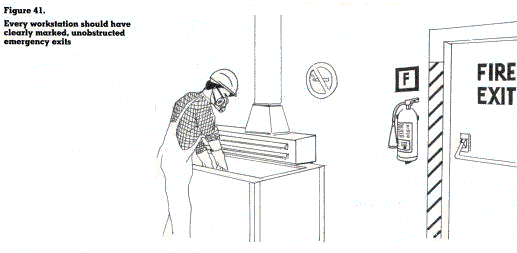
| Remember: Every workstation must have clear and unobstructed emergency exits. |
5.4. 1. The organization of a f first-aid service
Some form of first-aid service is essential to every workplace (figure 42). Additional requirements apply when hazardous substances are present. When a first-aid service is being considered, a number of aspects need to be evaluated:
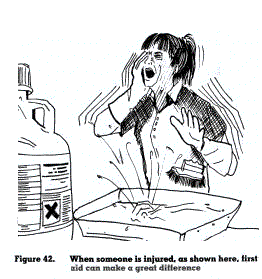
5.4.2. First aid for persons who come into contact with chemicals
It is essential that the provision of first aid to the victim of an accident puts neither the person providing the first aid nor the victim at further risk. In particular, when a worker needs to be rescued from a chemical area or is grossly contaminated, the rescuer needs to take precautions so that he or she does not become a victim:
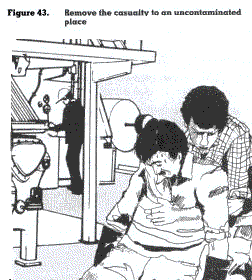

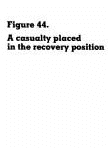
| Remember: Prior to administering first aid, the rescuer should ensure that the accident victim is in a safe environment The victim should be carefully moved if necessary. |
There are several very urgent priorities in providing first aid for a chemically injured worker:
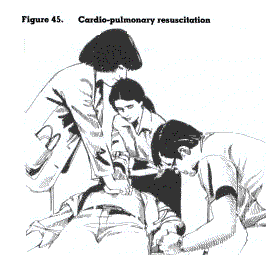
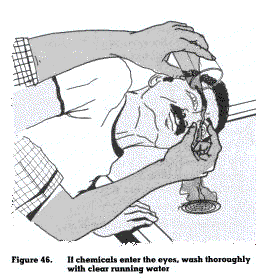
| Remember: Both mouth-to-mouth resuscitation and flushing of contaminated skin or eyes should be carried out while avoiding further injury. |
If a worker has accidentally swallowed a chemical substance, the first-aid treatment will depend on the nature of the substance. With most substances, if the worker is conscious, it is essential to make him or her vomit. With other substances such as petroleum products or organic solvents, it is dangerous to vomit. It is also dangerous to make an unconscious worker vomit. The label on the container or chemical safety data sheet may be able to provide the necessary guidance.
Any injured worker who is drowsy or unconscious must be rushed to a medical facility or hospital as quickly as possible, and accompanied by someone who is ready to give mouth-to-mouth resuscitation if it becomes necessary.
Even if the worker appears to be all right, seek medical assistance as rapidly as possible.
Discussion questions:
5.4.3. Role of poison information centres
A fair number of countries now have access to poisoning centres which have been setup in response to the growing need for medical advice about chemical and pharmaceutical products.
The role of each centre is essentially to provide a support service to doctors, emergency services and other health workers who are called upon to treat cases of acute poisoning. The service operates by reference to an extensive computerized index of substances which describes their toxicity, diagnosis and treatment. Advice is almost always in response to a telephone call or other means of obtaining an urgent reply. In some countries centres are operated 24 hours a day throughout the year.
Centres may also provide further services such as:
Employers and managers in enterprises where chemicals are used should establish contacts with poison information centres, where they exist. Such contacts have proved to be vital in saving lives in cases of chemical poisoning.
Should a small or a major lire occur, it is essential that everyone be clearly aware of their roles and responsibilities (figure 47). It is also very important that information be available describing the internal fire-protection equipment, procedures for evacuation of plant personnel, when and when not to fight fire, and how the location of specific chemicals (in storage or ' in process) might affect the safe fighting of fire.
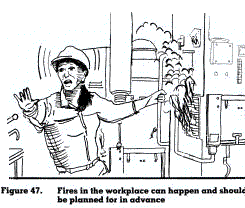
The pre-fire plan needs to be flexible, and will change as chemicals are added to or removed from the workplace. It will also alter as buildings, industrial processes and fire-protection equipment are put into service, removed from service or changed in any way.
For example, the role of an in-plant fire brigade should always be clearly defined in the pre-fire plan. This role will be very different if an automatic sprinkler system is in place and functioning. The brigade's task will be to assure the safe operation of the sprinkler system and support immediate evacuation from the affected area. The in-plant fire brigade's role may also change depending on the time it takes for a municipal fire service to arrive at the scene of a fire. If the response time is long, it may be necessary to develop a higher level of response within the plant.
As a minimum, the pre-fire plan should describe the following:
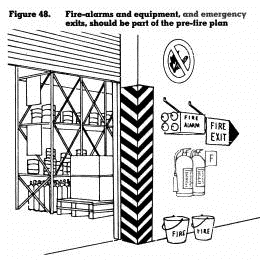
Most importantly, the pre-fire plan should list in detail the actions to be taken by all workers if there is a fire. The plan must state who is going to do what, when and where.
| Remember: the safety of the workers is of the highest priority. |
5.5.2. The organization of in-plant fire-fighting services
Depending on the size of the plant, the number of workers and the nearest sources of outside assistance, it may be worth while for a plant or a group of plants to organize an in-plant or shared industrial fire brigade.
If an in-plant fire brigade is trained, equipped and prepared to respond to chemical emergencies, the amount of time required to bring a chemical fire under control can be greatly reduced and financial losses considerably lessened.
If the plant fire brigade is to address chemical emergencies, it must consider the following:
It is strongly recommended that the plant owner or manager should establish direct contact with local or municipal fire services when considering whether or not t6 have a plant fire brigade address chemical emergencies.
5.5.3. Automatic fire protection
If a fire activates an automatic fire-protection system, the worker or in-plant fire brigade should not try to inhibit or interfere with the operation of the system. Many times has a minor fire become a major one because someone with good intentions prematurely shut down the automatic fire-protection system.
5.5.4. Selection of extinguishers
Portable fire extinguishers are very effective for the control of small chemical fires before they can assume large, uncontrollable proportions. It is imperative that the right fire extinguisher is chosen for a given chemical hazard (figure 49). The chemical safety data sheet will normally indicate the best extinguishing agent for a fire involving a given chemical substance. The type of extinguisher placed around the workstation should reflect the fire risk involved.
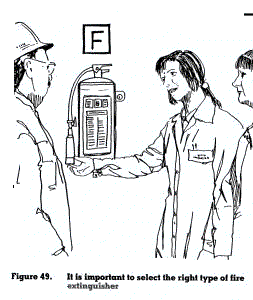
The choice of fire extinguishers for combined substances should only be considered after consultation with a person who is competent in the control of chemical fires.
Table 3. Types of fire extinguisher: Fire-fighting action and associated risks
| Type | Action | Risk |
| Pressurized water | Cools fuel rapidly | Conducts electricity
Reacts with some chemicals |
| Carbon dioxide | Removes oxygen | Displaces oxygen when used in confined spaces |
| Dry chemical | Interferes with the combustion process | When used in confined spaces, greatly limits visibility |
It must also be considered that certain types of behaviour of the chemical substances involve fire extinguisher have different risks associated with them. Table 3 indicates the fire-fighting action and associated risk of various types of extinguisher.
5.5.5. The decision to fight fire
The first priority in the control of a fire is to support efforts to evacuate plant personnel. A decision by the worker or a supervisor to fight a fire should be made only if it is considered possible to do so without any threat to life. Excessive heat, the risk of explosion, and the possibility of being overcome by a lack of breathable air or the risk of being trapped by a spreading fire should all be considered in making I this decision.
| Remember: If the decision is made to fight a chemical fire the following points should be taken into consideration:
|
5.6. Spill and leak procedures
If there is a spill of a hazardous chemical from a container" or a leak from a tank or other source such as a pipe or vessel, certain procedures should be followed. As with other emergencies, these procedures should always be planned in advance and documented in an emergency plan.
A key to the successful control of a spill or a leak is the knowledge of the properties and (figure 50). Again, the best source of information is the chemical safety data sheet for individual chemicals, or the plant chemist or occupational hygienist for spills that involve more than one chemical.
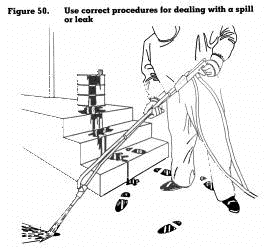
It is also essential that the plant personnel dealing with the spill or leak should immediately be able to judge whether or not the situation can be handled from within the plant or whether outside assistance is needed.
Depending on the size and nature of the spill or leak, and the hazardous chemical involved, the following steps must be taken:
| Remember: 1.Information on methods for dealing with spills and leaks can be found on the chemical safety data sheet. 2.The first priority must be the evacuation of non-essential personnel |
Discussion questions:
Suggested further reading: